Sadly, that’s true. Some decisions are very hard to make.
For anyone who wants to see the recommendations by departmen at WVUt:
https://provost.wvu.edu/academic-transformation/academic-program-portfolio-review
Sure, absolutely necessary—except that the structural deficit resulted largely, as I read the numbers and history, from boneheaded moves made by the upper administration these past few years.
So yeah, it makes total sense that the effects of that are felt by students, faculty, and low-level staff. (/s)
There is an excellent analysis of WVU’s predicament in today’s Chronicle of Higher Education.
Basically, around 2014, the school realized instate enrollment would drop or stay stagnant so it decided to pursue out-of-staters.
But the powers that be convinced themselves that attracting OOS required fancy new buildings and land. So the school went into sizable debt (!!!) to finance those purchases. The school was counting on its increased enrollment to pay down the debt. ![]()
Then Covid hit, the out-of-state enrollment boost didn’t materialize, international enrollment dried up, and in state demand shrank. Now, they have a huge operating deficit in the face of contracting demand and an impending demographic cliff. (And their reputation is toast.)
So, I’d say this looks far more like a story of bad management than politics or bad luck.
President Gee steps down in 1/2025.
Humanities faculty are, by and large, pretty cheap—people are often surprised at how little they make, given the discourse you hear about the “average” professor making $X per year (where X is a number higher than many people could even dream of making, ever). Never mind that that average is inflated by the inclusion of, say, professors of medical specialties who are bringing in 7 digits because they could make more than that in private practice (not to mention that, in some cases, those reports multiple faculty salaries by 4/3 to simulate year-round contracts). In addition, many humanities (but not just humanities) professors teach large sections. And it is, after all, much cheaper to staff a department of, say, German language and literature than a department of chemistry of the same size.
So if you include all tuition revenue for their classes (factoring in, of course, state tuition subsidies at public colleges), it is entirely possible for humanities professors to “pay for themselves”, even aside from the occasional but infrequent small grant and the very rare large one.
I’m not a fan. He was at CU, spent a ton of money, and then left when he got an offer that would benefit him personally.
He does move around a lot. " Why did Gee leave Ohio State? He said his age and the start of a long-term planning process at the university were also factors. "I live in turbulent times and I’ve had a lot of headwinds, and so almost every occasion, I have just moved on," he said. Gee explained away the abrupt timing by saying he was “quirky as hell” and hated long transitions.
It is not surprising that poor decisions made by upper management in any organization have results felt heavily by ordinary employees and customers, while the upper management who made those decisions has long since departed for other jobs based on other seeing the short term benefits of such decisions before the medium or long term problems resulting from such decision become obvious.
According to the ever-reliable Wikipedia, “Gee has held more university presidencies than any other American,” (source). In looking at all the moving around and seeing that his graduate degrees came from Columbia, it reminded me of @EyeVeee’s comment in the elite schools thread:
I’m not saying Gee is a dummie, but the number of moves as college president does make me wonder as to his effectiveness in the role.
Something interesting about WVU budget. I don’t know how reliable it is, but it is interesting:
Wow. Certainly sounds like poor management and negligent supervision at WVU. In any event, they are where they are, and it seems they need more than $40 million of cuts asap. There are no good options, just choices.
Unfortunately, you are correct. Also unfortunately, with that history of bad decisions, I can’t help but feel that they are likely making similarly bad decisions now. It’s difficult to trust the people who put WVU in this hole to pull them out of this hole.
This population density map has the misfortune to have my attempts at drawing the outlines of WV (in blue) and WY (in red) on it.
For the next two screen grabs, here is the population density key:

Here is a different population density view of West Virginia
And this is Wyoming (with some snips overlayed over one another because the state was too big to get this level of density on one screen):
Both states have lots of pale yellow, i.e. less than 50 people per square mile, though West Virginia does have more pockets of density than Wyoming.
Both states also have some mountainous areas:

This image, courtesy of Niche, shows the locations of the West Virginia 4-year publics.
And here is a map of the Wyoming 4-year public (note the singular):
If I was in Wyoming’s state government, I would have thought about placing the U. of Wyoming in Casper (which seems like the biggest population center in the middle of Wyoming), but the powers that be there chose to put their state school in the southeastern corner. Residents from all over Wyoming have to reside in Cheyenne if they’re going to attend college, and the university offers pretty much all fields, as expected of a flagship university.
West Virginia (the state), on the other hand, has twelve 4-year publics, according to Niche and College Navigator. As the state is now preparing to cut core programming from its flagship, that is obviously way too many schools. Looking at its population density, I could see the state going down to two state schools (WVU and either Marshall or West Virginia State), circled in GREEN. If it really wanted to have more across the state then I’d keep Shepherd and one of West Virginia Tech, Concord, or Bluefield State, circled in YELLOW. If it really wanted a fifth school, then I’d keep West Liberty, circled in ORANGE. The other 3 schools (WVU Parkersburg, Glenville State, and Fairmont State) would have to go, circled in RED. By closing 6 universities, that should be sufficient funding to make sure that one’s flagship is truly a flagship.
There’s the expression, jack of all trades and master of none. Ideally, a state flagship would be a master of all trades, but at a minimum, it should be a jack of all trades. The present proposal won’t let that be a feasibility for WVU. It’s far better to have fewer universities, and have each be good, strong universities, then have more universities that are not doing an effective job of providing higher education. (And in my not so humble opinion, if there is nobody on campus to teach a world language AT YOUR FLAGSHIP, you’re not doing an effective job of providing a higher education.)
One thing different about WY and WV is that WY appears willing to subside residential attendance costs for FAFSA EFC = $0 students attending University of Wyoming (NPC net price < $5k), while WV appears to be less willing (NPC net price ~$12.4k at WVU). This means that low income WV residents out of commuting range of an in-state public may not be able to afford an in-state public, unlike low income WY residents.
But perhaps having to maintain one state university instead of several means having the money to subsidize residential living for in-state students in a low population state where most students are out of commuting range regardless of where the state university is located.
![]()
It was WVU that miscalculated and overspent trying to draw in our of state students. I think it would be awful to shut down other publics to fix their mess.
Any college should have foreign language classes but taking from WV schools which have budgeted correctly to prop up WVU mismanagement is not something that seems fair or even likely to send the right message. I sincerely hope that is not what happens in this case.
I also wonder why posters do not have similar outrage about the cuts to engineering at WVU.
Looks like the proposed cuts in engineering are mainly reduction of faculty in response to decreasing enrollment, but the programs will “Continue at the Current Level of Activity with Specific
Action” (the action being reducing the number of faculty). The PhD programs in mining and petroleum / natural gas engineering are also to explore program mergers. These are less drastic actions than discontinuing the programs entirely.
It seems not enough kids take FL in college to keep those courses at WVU. Few schools ( other than top schools) require FL to graduate and not many students voluntarily enroll anymore. Some colleges do not even require it for admission.
Of my 2 kids, both placed out of FL requirements upon entering college-one chose to voluntarily continue study with 3 more courses; one happily never took another FL class.
Hard to generate interest in college FL when so many states opted out of requiring high school study.
The university is assessing program use by number of majors – and I’ve read that they didn’t even count double majors (not sure how they determined which major to count). I’ve also read that FL was one of the departments carrying more than its weight financially – so there were a lot of students taking FL without majoring. This is typical of humanities departments, actually – they tend to teach large general studies lecture courses (that part is not necessarily true of FL), and their faculty are paid less than those in STEM and pre-professional disciplines, so even if they have fewer majors, they’re still likely to come in under budget. (I wish I’d saved the links to this information, but this piece gives some idea: EDITORIAL: What WVU did, didn't consider in its review). I’m just not sure how you call yourself a flagship (or even a college or university) without offering any foreign language.






